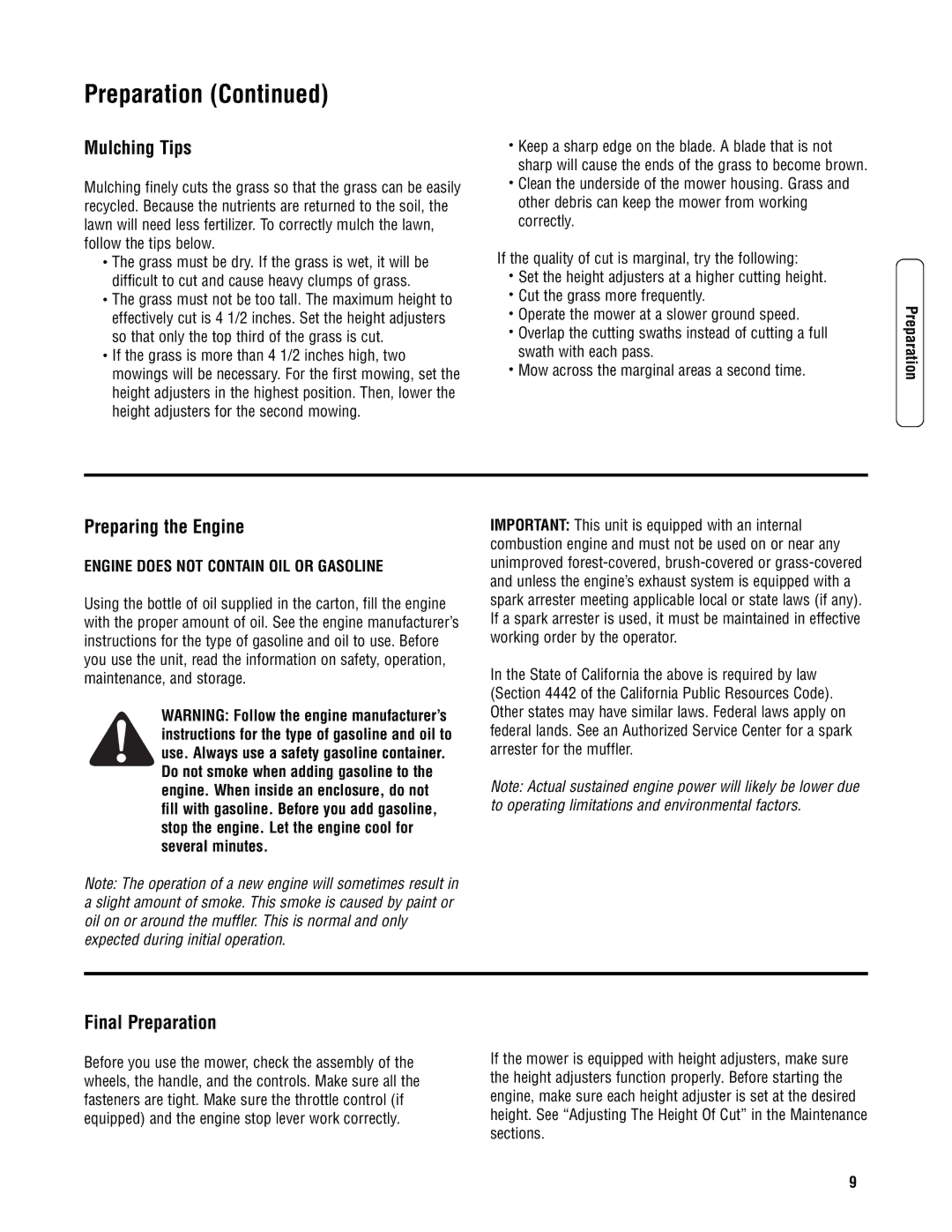
Preparation (Continued)
Mulching Tips
Mulching finely cuts the grass so that the grass can be easily recycled. Because the nutrients are returned to the soil, the lawn will need less fertilizer. To correctly mulch the lawn, follow the tips below.
![]() The grass must be dry. If the grass is wet, it will be difficult to cut and cause heavy clumps of grass.
The grass must be dry. If the grass is wet, it will be difficult to cut and cause heavy clumps of grass.
![]() The grass must not be too tall. The maximum height to effectively cut is 4 1/2 inches. Set the height adjusters so that only the top third of the grass is cut.
The grass must not be too tall. The maximum height to effectively cut is 4 1/2 inches. Set the height adjusters so that only the top third of the grass is cut.
![]() If the grass is more than 4 1/2 inches high, two mowings will be necessary. For the first mowing, set the height adjusters in the highest position. Then, lower the height adjusters for the second mowing.
If the grass is more than 4 1/2 inches high, two mowings will be necessary. For the first mowing, set the height adjusters in the highest position. Then, lower the height adjusters for the second mowing.
![]() Keep a sharp edge on the blade. A blade that is not sharp will cause the ends of the grass to become brown.
Keep a sharp edge on the blade. A blade that is not sharp will cause the ends of the grass to become brown. ![]() Clean the underside of the mower housing. Grass and other debris can keep the mower from working correctly.
Clean the underside of the mower housing. Grass and other debris can keep the mower from working correctly.
If the quality of cut is marginal, try the following:
![]() Set the height adjusters at a higher cutting height.
Set the height adjusters at a higher cutting height.
![]() Cut the grass more frequently.
Cut the grass more frequently.
![]() Operate the mower at a slower ground speed.
Operate the mower at a slower ground speed.
![]() Overlap the cutting swaths instead of cutting a full swath with each pass.
Overlap the cutting swaths instead of cutting a full swath with each pass.
![]() Mow across the marginal areas a second time.
Mow across the marginal areas a second time.
Preparation
Preparing the Engine
ENGINE DOES NOT CONTAIN OIL OR GASOLINE
Using the bottle of oil supplied in the carton, fill the engine with the proper amount of oil. See the engine manufacturer’s instructions for the type of gasoline and oil to use. Before you use the unit, read the information on safety, operation, maintenance, and storage.
WARNING: Follow the engine manufacturer’s instructions for the type of gasoline and oil to use. Always use a safety gasoline container. Do not smoke when adding gasoline to the engine. When inside an enclosure, do not fill with gasoline. Before you add gasoline, stop the engine. Let the engine cool for several minutes.
Note: The operation of a new engine will sometimes result in a slight amount of smoke. This smoke is caused by paint or oil on or around the muffler. This is normal and only expected during initial operation.
IMPORTANT: This unit is equipped with an internal combustion engine and must not be used on or near any unimproved
In the State of California the above is required by law (Section 4442 of the California Public Resources Code). Other states may have similar laws. Federal laws apply on federal lands. See an Authorized Service Center for a spark arrester for the muffler.
Note: Actual sustained engine power will likely be lower due to operating limitations and environmental factors.
Final Preparation
Before you use the mower, check the assembly of the wheels, the handle, and the controls. Make sure all the fasteners are tight. Make sure the throttle control (if equipped) and the engine stop lever work correctly.
If the mower is equipped with height adjusters, make sure the height adjusters function properly. Before starting the engine, make sure each height adjuster is set at the desired height. See “Adjusting The Height Of Cut” in the Maintenance sections.
9
